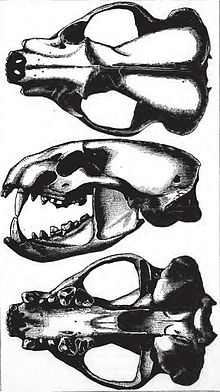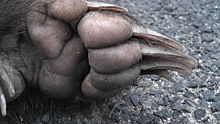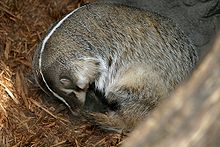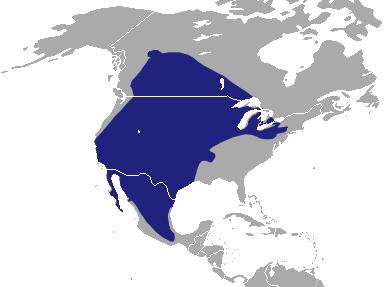 |
Canku Ota
|
 |
|
(Many Paths)
|
||
|
An Online Newsletter
Celebrating Native America
|
||
|
February 2018 - Volume
16 Number 2
|
||
|
|
||
|
American Badger
Taxidea taxus |
||
|
by Wikipedia, the free
encyclopedia
|
||
|
The American badger (Taxidea taxus) is a North American badger, somewhat similar in appearance to the European badger. It is found in the western and central United States, northern Mexico, and south-central Canada to certain areas of southwestern British Columbia. American badger's habitat is typefied by open grasslands with available prey (such as mice, squirrels, and groundhogs). The species prefers areas such as prairie regions with sandy loam soils where it can dig more easily for its prey. Taxonomy Recognized subspecies include: the nominate subspecies T. t. taxus, found in central Canada and central US; T. t. jacksoni, found in the southern Great Lakes region including southern Ontario; T. t. jeffersoni, in British Columbia and the western US; and T. t. berlandieri, in the southwestern US and northern Mexico. Ranges of subspecies overlap considerably, with intermediate forms occurring in the areas of overlap. In Mexico, this animal is sometimes called tlalcoyote. The Spanish word for badger is tejón, but in Mexico this word is also used to describe the coati. This can lead to confusion, as both coatis and badgers are found in Mexico. DescriptionThe American badger has most of the general characteristics common to badgers; with stocky and low-slung bodies with short, powerful legs, they are identifiable by their huge foreclaws (measuring up to 5 cm in length) and distinctive head markings. Measuring generally between 60 and 75 cm (23.5 and 29.5 in) in length, males of the species are slightly larger than females. They may attain an average weight of roughly 6.3 to 7.2 kg (14 to 16 lb) for females and up to 8.6 kg (19 lb) for males. Northern subspecies such as T. t. jeffersonii are heavier than the southern subspecies. In the fall, when food is plentiful, adult male badgers can reach up to 11.5 to 15 kg (25 to 33 lb). In some northern populations, females can average 9.5 kg (21 lb).
Except for the head, the American badger is covered with a grizzled, brown, black and white coat of coarse hair or fur, giving almost a mixed brown-tan appearance. The coat aids in camouflage in grassland habitat. Its triangular face shows a distinctive black and white pattern, with brown or blackish "badges" marking the cheeks and a white stripe extending from the nose to the base of the head. In the subspecies T. t. berlandieri, the white head stripe extends the full length of the body, to the base of the tail. Diet Behavior An abandoned badger burrow may be occupied by mammals of similar
size, such as foxes and skunks, as well as animals as diverse as
the burrowing owl, California Tiger Salamander and California Red-Legged
Frog. The American Badger has been seen working with a coyote in
tandem while hunting. Typically this pairing is one badger to one
coyote, however, one study found about 9% of sightings included
two coyotes to one badger, while 1% had one badger to three coyotes.
Researchers have found that the coyote benefits by an increased
catch rate of about 33%, and while it is difficult to see precisely
how the badger benefits, the badger has been noted to spend more
time underground and active. Badgers are also thought to expend
less energy while hunting in burrows. According to research, this
partnership works due to the different hunting styles of the predators
and how they prey reacts to them. A ground squirrel, upon spotting
a coyote, will crawl into its hole to escape; while upon seeing
a badger, the ground squirrel will climb out of its hole and use
its speed to out run the badger. Hunting in tandem raises the prey
vulnerability and both predators win.Life
cycle Badgers are born blind, furred, and helpless. Eyes open at four to six weeks. The female feeds her young solid foods prior to complete weaning, and for a few weeks thereafter. Young American badgers first emerge from the den on their own at five to six weeks old. Families usually break up and juveniles disperse from the end of June to August; young American badgers leave their mothers as early as late May or June. Juvenile dispersal movements are erratic. Most female American badgers become pregnant for the first time after they are a year old. A minority of females four to five months old ovulate and a few become pregnant. Males usually do not breed until their second year. Large predators occasionally kill American badgers. The average longevity in the wild is 9–10 years, with a record of 14; a captive example lived at least 15 years and five months. Habitat
American badger use of home range varies with season and sex. Different areas of the home range are used more frequently at different seasons and usually are related to prey availability. Males generally have larger home ranges than females. In a study almost 40 years ago, radiotransmitter-tagged American badgers had an average annual home range of 2,100 acres (850 hectares). The home range of one female was 1,790 acres (720 hectares) in summer, 131 acres (53 hectares) in fall, and 5 acres (2.0 hectares) in winter.[29] Lindzey reported average home ranges of 667 to 1,550 acres (270 to 627 ha). Estimated density of American badgers in Utah scrub-steppe was one per square mile (2.6 km2), with 10 dens in active or recent use. As of 2014, overdevelopment of American Badger habitat had resulted in reduced range, decreased prey, and forced badgers into contact with man foraging between fragments. Direct observations in Sonoma County, documenting habitat and badger sightings and foraging, reflect various ranges within the fragmented habitat areas from less than 1/2 mile to approximately 4 miles. Within these areas, the availability of prey and a fresh water source are key factors for the preferred habitat areas and ability to survive. Identifying and conserving habitat areas where there is year-round activity, along with identified burrowing patterns and observations of female badger territory for birthing and raising young have become critical factors in survival of the species. Plant communities In Colorado in 1977, American badgers were common in grass–forb and ponderosa pine habitats. In Kansas, they are common in tallgrass prairie dominated by big bluestem (Andropogon gerardi), little bluestem (Schizachyrium scoparium), and Indian grass (Sorghastrum nutans). In Montana 24 years ago, badgers were present in Glacier National Park in fescue (Festuca spp.) grasslands. In Manitoba, they occur in grassland extensions within aspen (Populus spp.) parklands. Cover requirements During summer and autumn, badgers range more frequently, with mating season generally in November, and burrowing patterns reflect 1 to 3 burrows may be dug from foraged out prey holes in a day, used for a day to a week, and then abandoned, with possible returns later, and other small wildlife utilizing abandoned burrows in the interim. Where prey is particularly plentiful, they will reuse dens, especially in the fall, sometimes for a few days at a time. In winter, a single den may be used for most of the season. Natal dens are dug by the female and are used for extended periods, but litters may be moved, probably to allow the mother to forage in new areas close to the nursery. Natal dens are usually larger and more complex than diurnal dens. Predation American badgers are trapped by humans for their pelts. Their fur is used for shaving and painting brushes. Conservation status |
|||||||||||||||
|
|
|
||
|
|
||
| Canku Ota is a free Newsletter celebrating Native America, its traditions and accomplishments . We do not provide subscriber or visitor names to anyone. Some articles presented in Canku Ota may contain copyright material. We have received appropriate permissions for republishing any articles. Material appearing here is distributed without profit or monetary gain to those who have expressed an interest. This is in accordance with Title 17 U.S.C. Section 107. | ||
|
Canku Ota is a copyright ©
2000 - 2018 of Vicki Williams Barry and Paul Barry.
|
||
 |
 |
|
|
The "Canku
Ota - A Newsletter Celebrating Native America" web site and
its design is the
|
||
|
Copyright ©
1999 - 2018 of Paul C. Barry.
|
||
|
All Rights Reserved.
|
||



